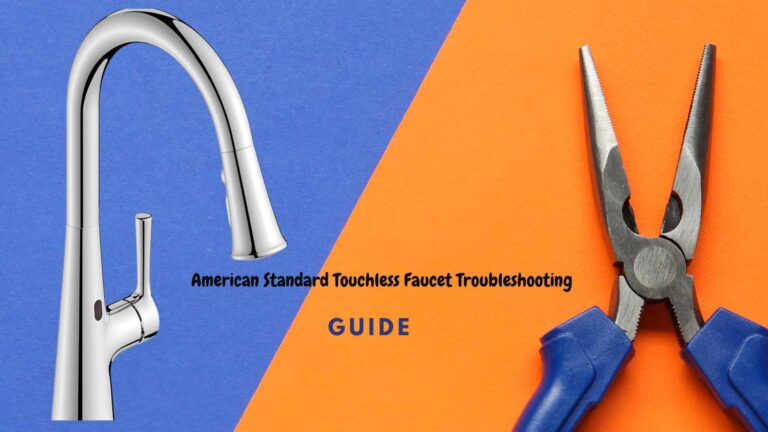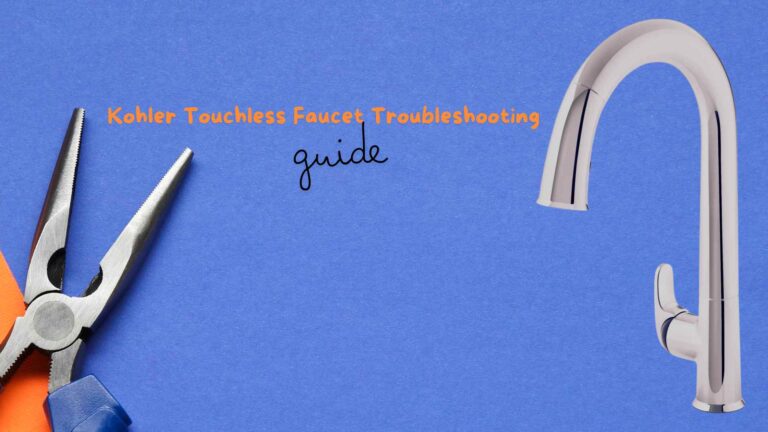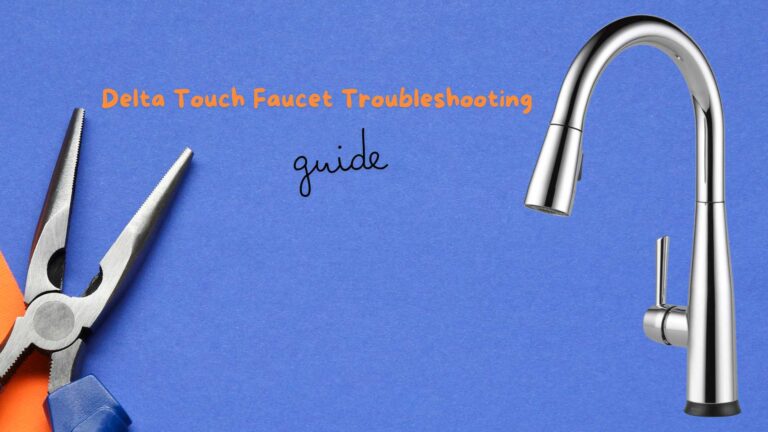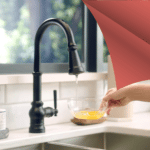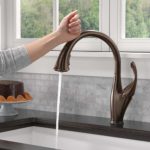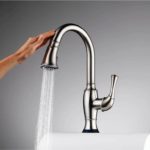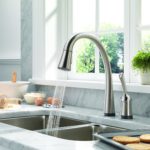Connecting a garden hose to kitchen faucet is a great way to provide water for a variety of purposes outside. A kitchen faucet located near the back door can make it easy to keep pots, flower beds and hanging baskets well watered. The cool drink of water you give your dog will be closer than ever. You can even wash your car if you want. Connecting the hose to the faucet only requires a faucet hose adapter.
The adapter is a small device that connects to the faucet on one end and fits over the hose on the other end. They come in various sizes, so you may need to get one that fits your particular faucet. To install it, simply twist it clockwise onto the end of the faucet. Be sure that you screw it on tightly enough to prevent leaks, but not too tight or you may damage it.

How to attach a garden hose to kitchen faucet?
If you are one of those people who would rather spend your time working in the yard than inside the house, then you know how difficult it can be to move from the garden to the kitchen. Using a garden hose that is attached to your kitchen faucet will make it a lot easier for you to get from one place to another.
Connecting a garden hose to your kitchen faucet is not as hard as you might think; in fact, with this step-by-step guide, you will have no trouble at all.
Step 1: Get Your Hose Adapter
To begin with, you’ll want to get your hands on a kitchen faucet to garden hose adapter. You’ll find several types, including swivel ones, snap-in-ones, or diverter ones. You can pick up one of these adapters at your local home improvement store for no more than $15. Here are some of the best sink faucet to hose adapters we found on Amazon.

- The quick installation kit includes a snap buckle and a male with a 360° rotation.
- Quick connector has internal thread 55/64" -27 , suitable for M22 (55/64" -27) female thread faucet. Includes a female thread adapter (M22xM24), which is 15/16" -27 male (top) and 55/64" -27 male (bottom), suitable for M24 (15/16" -27) internal threaded faucet.
- Quick connector adapter provides two threads: 1. Standard G1 / 2" t; 2. Standard 3/4 inch GHT garden hose.
- This quick-connect adapter kit is well designed, a simple plug-and-play adapter can provide a firm, leak-free connection.

- Faucet to hose aerator adaptor allows connection to standard 3/4-Inch male hose thread.
- Converts standard male (15/16-Inch x 27 thread) or female (55/64-Inch x 27 thread) aerator to 3/4-Inch male hose thread or 55/64-Inch x 27 male thread.
- Solid Brass faucet adapter with swivel, Garden Hose can swivel when connected.
- Another male(15/16-Inch x 27 thread) to male(55/64-Inch x 27 thread) adapter is included.
- Faucet adapter can swivel 360 degree, so garden hose can swivel when connected to help prevent water hose bending.

- The faucet diverter adapter is made of high-quality solid brass, and the surface is chrome-plated to resist rust and corrosion
- : The thread of the diverter is G1/2 is used to connect the shower hose, with the G1/2 to 3/4GHT adapter that can be connected to the garden hose.
- The divider has an aerator and an external thread adapter, which can be connected to various bathroom faucets or kitchen sink faucets by removing the faucet aerator.
- The manifold has 55 / 64-27 female threads, including a male thread adapter 55 / 64-27 male threads and 15 / 16-27 male threads
Step 2: Turn Off the Water Supply Valve
Next, you’ll want to turn off your water supply at the main shutoff valve. You should close the valves that are located under your sink before moving on with this process.
Step 3: Unscrew the Aerator from the End of the Spout on Your Kitchen Faucet
In order for the adapter to fit properly onto your faucet spout, you need to unscrew the aerator from the end of it. The aerator is located at the very tip of the spout, where the stream of water comes out when you turn on your faucet. If this is giving you trouble, try unscrewing it with pliers or a wrench.
Step 4: Screw One End of Your Faucet Hose Adapter
Screw one end of your faucet hose adapter onto the threaded part that sticks out from where the aerator was attached to your kitchen faucet. Make sure it’s tight so that it doesn’t leak when you turn it on later!
Step 5: Connect the Hose to the Other End of the Adapter
Next, connect the hose to the other end of the adapter and make sure it’s secured well. At this point, you can turn the water supply valve on and test for any leaks.
How do you hook up a garden hose to a pull down faucet?
It’s no secret that we’re big fans of touchless faucets. And why not? They’re a great alternative to the standard faucet, and they’re just plain cool. But with all the benefits that come from using a touchless faucet, there is one drawback: you will not be able to hook up a garden hose to your sink. The reason: the pull down sprayers found on most touchless faucets but also other styles and shapes of faucets without an aerator are not designed to accommodate a garden hose attachment.
Soo what can you do?
You can easily do this with some adapters that are available on the market and will review further.
The Water Bandit is available on Amazon and it is cheap It’s a very simple device that you can use to connect your garden hose to a pull down faucet. All you have to do is attach it to the spout of your faucet and then attach the other end to the hose. This should make it easier for you to water your plants or garden. It is also great for filling up buckets and watering cans, which makes it an excellent tool. The funnel shape works very well with most types of pull down faucets, including bathroom sinks and kitchen sinks as well as outdoor spigots.
A portable rubber sink hose is a useful tool for washing your hands or even rinsing out a bucket or other container. You can use this type of connector to attach it to your pull down faucet. It's a very simple device and it works reasonably well with low water pressure, but if you have an electric pump or high-pressure city water then the moving parts will leak.
The universal garden hose adapter is an easy way to connect your garden hose to any pull down faucet. The adapter's comfortable rubberized grip makes it easy to screw the device onto your faucet, and the special clamp can be tightened or loosened depending on the size of the faucet. Simply twist or tighten the clamp to secure the adapter in place. Once hooked up, you'll be able to access water from your kitchen faucet with a simple turn of a handle.
If you need a more permanent solution to connect your garden hose to kitchen faucet. You will need to install a hose bib under the sink with a shutoff valve. The whole process takes more time, tools, and a little plumbing knowledge than will discuss in a future post.
FAQ about garden hose adapters
Why do I need garden hose fittings?
Garden hoses are an essential component of any home improvement project. Whether you’re working on your garden or cleaning up after a storm, these accessories are an essential part of the process. They connect two ends of a hose together at various lengths and diameters so that you can easily move water from one area to another.
What size is a standard garden hose fitting?
The most common size used for garden hoses is 5/8″ or 3/4″. This is a “standard” size that fits with most other standard garden hose fittings, such as faucets, sprinklers and so on.
What are the different types of garden hose fittings?
There are two main types of garden hose fittings; male and female. The male fitting has a hexagonal shape and screws onto the end of your garden hose. The female fitting is round, and has a hole in the center that fits over the male fitting to secure it.
Are brass or plastic garden hose connectors better?
The choice between brass and plastic garden hose connectors is a matter of personal preference. Both types of connector have their pros and cons.
Brass Garden Hose Fittings
Brass is more durable than plastic. It doesn’t crack, rust or break as easily, so it’s likely to last longer than a plastic garden hose connector. The price tag on brass fittings is higher than that of plastic ones, but they’re worth the investment if you want your garden hoses to last for years.
Plastic Garden Hose Connectors
Plastic connectors are less expensive than brass ones, but they’re not as sturdy or reliable in the long run. If you’re looking for an inexpensive solution that will still hold up over time, then plastic might be right for you. Plastic connectors also come in a variety of colors, which can make them more attractive than plain brass fittings
Which Should You Choose?
If you’re looking for something that will last forever without any maintenance, then brass is probably your best bet (and it will probably fit your budget as well). If you want something that’s more affordable in the short term, then plastic may be the way to go
Conclusion
The process to connect a hose to a kitchen faucet is very easy and virtually anyone can do it. It’s just finding the right adapter for your particular faucet that might be slightly more difficult. The advantage of connecting a garden hose from your kitchen faucet is obvious; you have an outside water source in close proximity to your house, so you can keep your houseplants well-watered, wash your car with ease or have cold water on tap for your pets and various other purposes.





